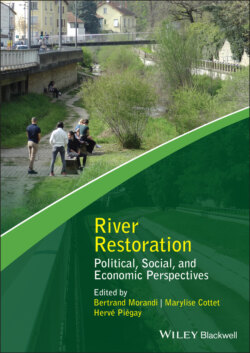Читать книгу River Restoration - Группа авторов - Страница 36
1.6 A book to share a diversity of societal approaches in the field of river restoration 1.6.1 What will you find in this edited book?
ОглавлениеThis book is the result of a long collaborative process. It stems from the observation that many researchers have worked for many years on the societal issues of river restoration. However, these scientific commitments remain relatively short term and are most often carried out within the framework of interdisciplinary projects led primarily by the natural sciences. Researchers addressing the social, political, or economic issues raised by restoration are relatively isolated when it comes to their ability to consider common reflexive approaches and share their work with the broader community working in river restoration. For example, there are few major dedicated events where they can come together to exchange and discuss the approaches, scientific results, and operational perspectives opened up by their research. This book was conceived to open up a space for sharing such perspectives, and to highlight the rich and dynamic interdisciplinary community.
This book forms a compendium of the diversity of scientific work carried out over the last ten years on societal challenges to river restoration. It proposes 14 contributions by researchers from different research fields, such as environmental economics, critical physical geography, human or social geography, hydromorphology, ecology and biology, sustainable management studies, philosophy and ethics, political ecology, political science, architecture and urban studies, and anthropology. Each of these disciplines enriches the book with concepts and methods from different epistemological traditions. Some contributions propose syntheses of already published works, whereas others present original studies. Most of them base their analysis on case studies and empirical data. To account for the diversity of the environmental, sociopolitical, and cultural contexts in which river restoration takes place, the contributions of this book are international. They come from research teams in Austria, France, the Netherlands, New Zealand, Spain, Switzerland, the United Kingdom, and the United States of America. Collecting these contributions together makes it possible to emphasize their complementary nature. This compendium is intended to be a showcase of research achievements: questions, methods, and scientific results. It provides stimulating perspectives for understanding restoration in its social, economic, and political dimensions.
